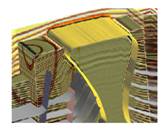Prestack Depth Migration
 |
Prestack depth migration is essential to seismic reflection imaging in areas where steeply dipping structures or extreme lateral velocity variations exist in the subsurface, such as along the flanks of salt domes or in strike-slip fault zones. Raypath distortions can be so severe in areas of complex velocity variations that conventional poststack processing often destroys reflection information. To obtain a better quality image through depth migration, an accurate velocity model is required. However, the more complex the geology, the more difficult it is to find an accurate velocity model. |
In addition to Passive velocity methods, when required, LandTech records a highly redundant data set in a wide range of offset (up to 20km or more), in order to perform stable inversions of first arrivals, near vertical and wide angle reflections. Successively the data can be pre-stack depth migrated, including also near critical or post critical events.
The velocity field obtained by the tomographic inversion of arrivals of selected reflectors. The velocity field can be used to perform the pre-stack depth migration of the data. This procedure is particularly important in areas with lateral velocity variations and complex geometries. The final result gives a section where the structures are closer to the real case than in time sections.
The benefits of extending the acquisition offsets are evident in areas where there are thick carbonates, complex thrusts and sub-salt. In these conditions, the use of a long acquisition spread allows the undershooting of the high-impedance bodies, the increase of the S/N ratio in the reflected events when approaching the critical angle and more reliable velocity analysis by means of tomographic methods.